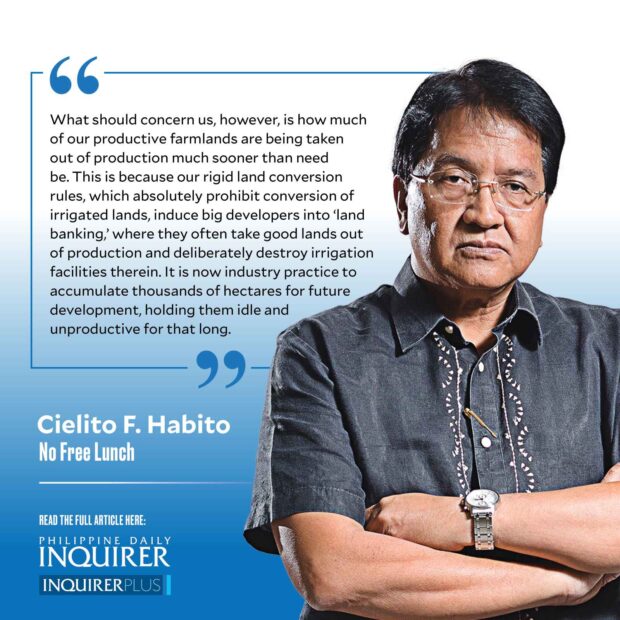Easing land conversion

At the individual farm level, our farms are indeed shrinking. Average farm size in the country is down to 1.2 hectares, and still falling. It was 3.6 hectares in 1960 and 2.8 hectares in 1980. It shrank even more since then mainly due to the Comprehensive Agrarian Reform Program, which limited land ownership to 5-7 hectares, worsened by generational partitioning. This has led to the loss of productivity from economies of scale, which could be mitigated by farming the lands more intensively (that is, applying more productivity-raising inputs like better seeds, fertilizers, and farm management). But lack of access to finance, and government’s failure to fill this critical need, kept small farmers from doing so. Instead of emancipating small farmers, they became even poorer.
Surprisingly, the fear that we’re losing our farms in the face of land conversions appears to be a myth. World Bank data show that our agricultural area, as a percentage of our fixed total land area, actually kept expanding over time, up to the present. From 25.9 percent in 1961, it grew to 35.6 percent in 1980, 37.7 percent in 2000, 40.6 percent in 2010, and 42.5 percent in 2020. I cross-checked this with the Philippine Statistics Authority’s annual Selected Statistics on Agriculture and Fisheries, which reported total crop area planted at 13.032 million hectares in 2009, 13.229 mha in 2015, and 13.538 mha in 2021.
Article continues after this advertisementAre fears of dwindling farm areas from land conversion misplaced, then? It would seem so, with our total recorded farm hectarage actually rising! What appears to be happening is that as farmlands are converted, more of our less suitable lands (including forest uplands) are being tilled. Indeed, World Bank data also show that we now cultivate twice more (36 percent of total land area) than our arable land area (18.2 percent of land area). The comparable numbers are 45 vs. 32.9 percent (1.37 times) for Thailand and 32.7 vs. 20.6 percent (1.59 times) for Vietnam.
What should concern us, however, is how much of our productive farmlands are being taken out of production much sooner than need be. This is because our rigid land conversion rules, which absolutely prohibit conversion of irrigated lands, induce big developers into “land banking,” where they often take good lands out of production and deliberately destroy irrigation facilities therein. It is now industry practice to accumulate thousands of hectares for future development, holding them idle and unproductive for that long. This is because the land has to be unirrigated and unproductive to be eligible for conversion—usually up to 10-15 years later. A bank branch manager attested to me how he had witnessed developer clients willfully destroy existing irrigation facilities because having them will run counter to what they will want to prove years later.
I witnessed the problem firsthand in a depressed Laguna municipality when I led a team in a study on rural poverty a few years ago. Numerous local farmers ended up with no income source after a large property developer bought up hundreds of hectares of their farmlands, rendering them untouchable henceforth. It was a great waste, and a huge lost opportunity to otherwise provide livelihoods to hundreds of farmers and their families, if only they could still lease their former farms and produce food in and earn incomes from them—while the developer also earns lease income.
Article continues after this advertisementI’ve never believed it realistic or practical to be overly rigid on land conversion. Why ban conversion of irrigated lands, when we can instead impose a condition that for every hectare of land converted, the developer causes the irrigation of two or more hectares of unirrigated land elsewhere? With a little out-of-the-box thinking, we get not only a win-win outcome but a net gain for all concerned.
cielito.habito@gmail.com
















